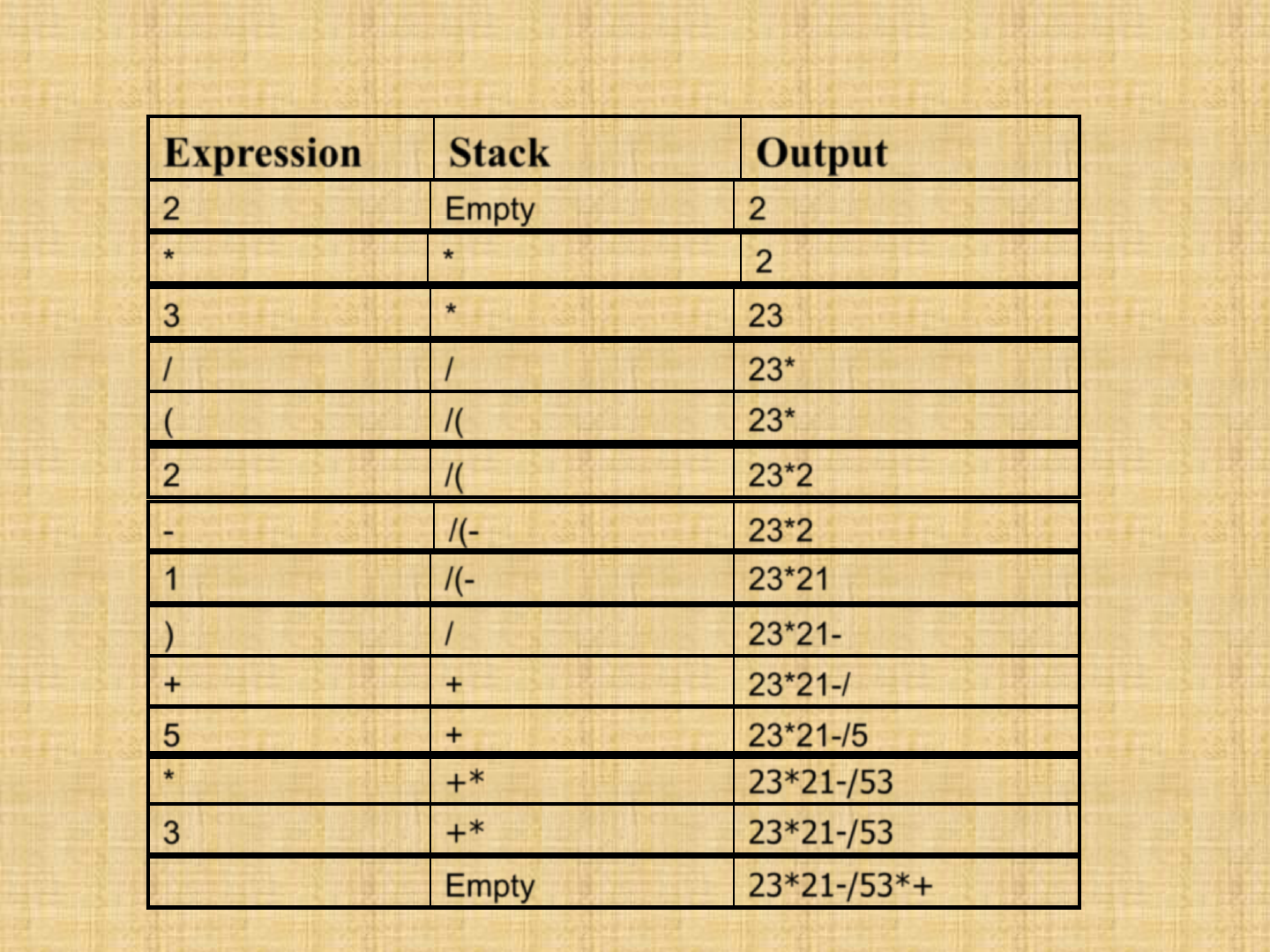
Application of Stacks
(Infix, Postfix and Prefix Expressions)

Algebraic Expression
• An algebraic expression is a legal combination of operands and
the operators.
• Operand is the quantity (unit of data) on which a mathematical
operation is performed.
• Operand may be a variable like x, y, z or a constant like 5, 4,0,9,1
etc.
• Operator is a symbol which signifies a mathematical or logical
operation between the operands. Example of familiar operators
include +,-,*, /, ^
• Considering these definitions of operands and operators now we
can write an example of expression as x+y*z.

Infix, Postfix and Prefix Expressions
• INFIX: From our schools times we have been familiar with the
expressions in which operands surround the operator, e.g.
x+y, 6*3 etc this way of writing the Expressions is called infix
notation.
• POSTFIX: Postfix notation are also Known as Reverse Polish
Notation (RPN). They are different from the infix and prefix
notations in the sense that in the postfix notation, operator
comes after the operands, e.g. xy+, xyz+* etc.
• PREFIX: Prefix notation also Known as Polish notation.In the
prefix notation, as the name only suggests, operator comes
before the operands, e.g. +xy, *+xyz etc.

Operator Priorities
• How do you figure out the operands of an
operator?
– a + b * c
– a * b + c / d
• This is done by assigning operator priorities.
– priority(*) = priority(/) > priority(+) = priority(-)
• When an operand lies between two operators,
the operand associates with the operator that
has higher priority.

Examples of infix to prefix and post fix
Infix PostFix Prefix
A+B AB+ +AB
(A+B) * (C + D) AB+CD+* *+AB+CD
A-B/(C*D^E) ABCDE^*/- -A/B*C^DE

Example: postfix expressions
• Postfix notation is another way of writing arithmetic
expressions.
• In postfix notation, the operator is written after the two
operands.
infix: 2+5 postfix: 2 5 +
• Expressions are evaluated from left to right.
• Precedence rules and parentheses are never needed!!

Suppose that we would like to rewrite
A+B*C in postfix
• Applying the rules of precedence,we obtained
A+B*C
A+(B*C) Parentheses for emphasis
A+(BC*) Convert the multiplication,Let D=BC*
A+D Convert the addition
A(D)+
ABC*+ Postfix Form

Postfix Examples
Infix Postfix Evaluation
2 - 3 * 4 + 5 2 3 4 * - 5 + -5
(2 - 3) * (4 + 5) 2 3 - 4 5 + * -9
2- (3 * 4 +5) 2 3 4 * 5 + - -15
Why ? No brackets necessary !

When do we need to use them…
• So, what is actually done is expression is
scanned from user in infix form; it is converted
into prefix or postfix form and then evaluated
without considering the parenthesis and
priority of the operators.

Algorithm for Infix to Postfix
1) Examine the next element in the input.
2) If it is operand, output it.
3) If it is opening parenthesis, push it on stack.
4) If it is an operator, then
i) If stack is empty, push operator on stack.
ii) If the top of stack is opening parenthesis, push operator on stack
iii) If it has higher priority than the top of stack, push operator on stack.
iv) Else pop the operator from the stack and output it, repeat step 4.
5) If it is a closing parenthesis, pop operators from stack and output them
until an opening parenthesis is encountered. pop and discard the opening
parenthesis.
6) If there is more input go to step 1
7) If there is no more input, pop the remaining operators to output.

Suppose we want to convert 2*3/(2-1)+5*3 into Postfix form,
So, the Postfix Expression is 23*21-/53*+
2 Empty 2
* * 2
3 * 23
/ / 23*
( /( 23*
2 /( 23*2
- /(- 23*2
1 /(- 23*21
) / 23*21-
+ + 23*21-/
5 + 23*21-/5
3 +* 23*21-/53
Expression Stack Output
* +* 23*21-/53
Empty 23*21-/53*+

Example
• ( 5 + 6) * 9 +10
will be
• 5 6 + 9 * 10 +

Evaluation a postfix expression
• Each operator in a postfix string refers to the previous
two operands in the string.
• Suppose that each time we read an operand we push it
into a stack. When we reach an operator, its operands
will then be top two elements on the stack
• We can then pop these two elements, perform the
indicated operation on them, and push the result on the
stack.
• So that it will be available for use as an operand of the
next operator.

Evaluating Postfix Notation
• Use a stack to evaluate an expression in
postfix notation.
• The postfix expression to be evaluated is
scanned from left to right.
• Variables or constants are pushed onto the
stack.
• When an operator is encountered, the
indicated action is performed using the top
elements of the stack, and the result
replaces the operands on the stack.

Evaluating a postfix expression
• Initialise an empty stack
• While token remain in the input stream
–Read next token
–If token is a number, push it into the stack
–Else, if token is an operator, pop top two tokens
off the stack,apply the operator, and push the
answer back into the stack
• Pop the answer off the stack.

Example: postfix expressions
(cont.)

Postfix expressions:
Algorithm using stacks (cont.)

Algorithm for evaluating a postfix
expression (Cond.)
WHILE more input items exist
{
If symb is an operand
then push (opndstk,symb)
else //symbol is an operator
{
Opnd1=pop(opndstk);
Opnd2=pop(opndnstk);
Value = result of applying symb to opnd1 & opnd2
Push(opndstk,value);
} //End of else
} // end while
Result = pop (opndstk);

Question : Evaluate the following
expression in postfix :
623+-382/+*2^3+
Final answer is
• 49
• 51
• 52
• 7
• None of these

Evaluate- 623+-382/+*2^3+
Symbol opnd1 opnd2 value opndstk
6 6
2 6,2
3 6,2,3
+ 2 3 5 6,5
- 6 5 1 1
3 6 5 1 1,3

Evaluate- 623+-382/+*2^3+
Symbol opnd1 opnd2 value opndstk
8 6 5 1 1,3,8
2 6 5 1 1,3,8,2
/ 8 2 4 1,3,4
+ 3 4 7 1,7
* 1 7 7 7
2 1 7 7 7,2
^ 7 2 49 49
3 7 2 49 49,3
+ 49 3 52 52
